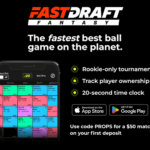Since its debut in August 2024, FastDraft Fantasy has lived up to its moniker with an efficient, easy-to-use and rewarding Best Ball drafting experience for its users. The FastDraft app makes a strong initial first impression with a clean interface that clearly delineates between the platform’s Best Ball and DFS contests.
Given its existence within what is an increasingly crowded Best Ball product market, FastDraft’s offerings prioritize an attempt to differentiate to the benefit of the fantasy player seeking flexibility and variety in their Best Ball fare. The platform also keeps pace with its competition by offering lucrative prize pools of between $5,000 and $25,000 in its contests.
FastDraft Contest Types
FastDraft Best Ball multi-entry tournament contests are available in three different formats: Origins, D-Up! and Flex 4, all which feature positionless rosters.
- Origins are contests that consist of the fantasy player drafting six incoming rookies at any skill position. These contests fully embrace the combination of anticipation and uncertainty inherent in prognosticating the level of production top first-year players will be able to generate in their initial NFL seasons.
- D-Up! is FastDraft’s latest offering, and it requires a fantasy player to draft six defensive linemen, linebackers or defensive backs. These contests, essentially an extension of IDP-only season-long fantasy leagues, certainly bring in a different strategic element from the norm due to the complete absence of offensive players/statistics.
- Flex 4 is what could be considered FastDraft’s more traditional Best Ball product, with one key exception – there is no quarterback. The fantasy player will draft six total running backs, wide receivers or tight ends, and the top four scores each week will count toward the fantasy player’s total.
Unique FastDraft Fantasy Features
In either of the three contest types, the fantasy player will also be setting Boosters, which are multipliers at the 2x, 1.75x, 1.5x and 1.25x levels. Fantasy players are allowed to apply one of each booster to a rostered athlete for the duration of the season, and in turn, the production generated by that athlete will be multiplied accordingly.
Boosters can be modified within a roster until the set Booster Lock date and time, which is set for just before the start of the opening Thursday Night Football game of the NFL regular season.
Additionally, FastDraft has Turbo Mode, an innovative feature that offers the mutual benefit to the platform and its fantasy players of allowing the latter to maximize the number of Best Ball drafts he/she wants to enter without having to be present for those drafts.
The fantasy player will simply select the number of Best Ball drafts they want to enter and set their player rankings for each. After the drafts are complete, the fantasy player can go back to each roster and apply their Booster levels to each player.
Even without Turbo Mode activated, FastDraft already lives up to its name by making its contests six rounds in length with a 20-second pick timer. With FastDraft’s contests also limited to 10 teams, Best Ball drafts are completed very quickly, a significant convenience for the busy fantasy player who’s seeking to maximize Best Ball action while still being present for the draft.
Why FastDraft Instead of Other Best Ball Options
- Innovative, Diverse Formats: The flexibility of choosing between the three contests formats, each which has its own unique strategic elements, is one of its most appealing features. Not only does it allow one to truly diversify a Best Ball portfolio in terms of contest types, but playing all three certainly sharpens a fantasy player’s overall knowledge within that particular season’s landscape, which could pay off when playing any number of other season-long fantasy formats.
- Booster Feature: Playing with fantasy scoring multipliers is something that both season-long and DFS players are already familiar with. However, the strategic process of deciding how to assign four different multiplier levels to one roster and having those decisions apply for the duration of an entire regular season brings a very different element into play.
- Multiple Tracking Options for Pertinent Information: I enjoy FastDraft’s platform-wide commitment to keeping pertinent information the fantasy player can benefit from within easy, convenient reach. This includes ADP Movers and News features that provide fantasy players with details on which athlete’s draft positions are rising and falling the most and general up-to-the-minute developments, respectively. Moreover, the platform’s Portfolio allows you to track your exposure to players at each position across all your Best Ball contests on the platform, as well as how you’ve distributed Boosters across athletes and how the ADP of your drafted players compares that same athlete’s overall ADP on the platform.


